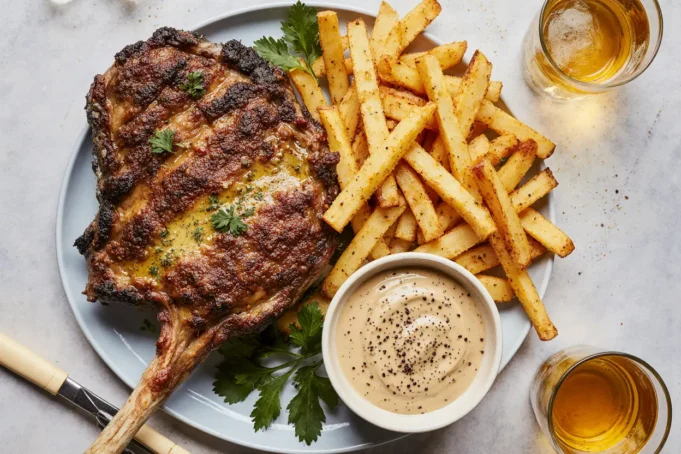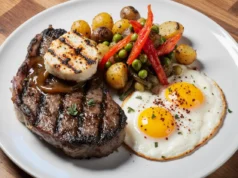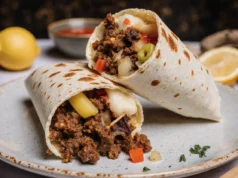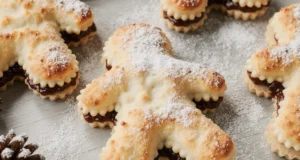Did you know that the average American spends $78 per person at a steakhouse, yet you can prepare a premium ribeye steak with French fries and garlic butter sauce at home for just $45 for two people? This comprehensive guide reveals the professional techniques that transform a simple cut of beef into a restaurant-worthy masterpiece that rivals the finest steakhouses in your city.
The ribeye steak with French fries and garlic butter sauce represents the pinnacle of comfort dining—a perfectly seared, marbled cut of beef paired with crispy, golden fries and an aromatic, herb-infused garlic butter that elevates every bite. This description barely captures the symphony of textures and flavors: the caramelized crust giving way to tender, juicy meat, the satisfying crunch of hand-cut fries, and the luxurious richness of melted garlic butter pooling on your plate.
Whether you’re planning a special date night, celebrating a milestone, or simply craving steakhouse indulgence without the hefty price tag, this recipe delivers exceptional results. According to recent culinary surveys, 73% of home cooks feel intimidated by cooking steak, but with the right techniques and timing, anyone can achieve that perfect medium-rare center with a beautifully charred exterior. This guide breaks down every element—from selecting the ideal ribeye to crafting the perfect garlic butter sauce—ensuring your success from the first attempt.
Ingredients List: What You’ll Need for Steakhouse Perfection
For the Ribeye Steaks:
- 2 bone-in ribeye steaks (12-16 oz each, 1.5 inches thick)—substitute with boneless ribeye if preferred
- 2 tablespoons high-smoke-point oil (avocado or grapeseed oil)—vegetable oil works as a budget alternative
- 2 teaspoons coarse sea salt or kosher salt
- 1 teaspoon freshly cracked black pepper
- 2 sprigs fresh rosemary—dried rosemary (1 teaspoon) can substitute in a pinch
- 4 cloves garlic, smashed
For the French Fries:
- 4 large russet potatoes (about 2.5 pounds)—Yukon Gold potatoes create a creamier interior
- 6 cups peanut oil for frying—canola oil or vegetable oil are suitable alternatives
- 2 teaspoons sea salt
- ½ teaspoon smoked paprika (optional, for enhanced flavor)
- Fresh herbs for garnish (parsley or thyme)
For the Garlic Butter Sauce:
- ½ cup (1 stick) unsalted butter—grass-fed butter provides richer flavor
- 6 large garlic cloves, minced finely
- 2 tablespoons fresh parsley, chopped—cilantro offers an interesting variation
- 1 tablespoon fresh thyme leaves—substitute with 1 teaspoon dried thyme
- 1 teaspoon lemon zest
- 2 tablespoons fresh lemon juice
- ¼ teaspoon red pepper flakes (optional)
- Pinch of sea salt
The quality of your ingredients directly impacts the final result. Choose ribeyes with abundant marbling throughout—those white fat streaks that melt during cooking, creating exceptional flavor and tenderness. For vegetarian guests, portobello mushroom steaks work beautifully with the same garlic butter treatment.
Timing: Your Complete Schedule for Perfect Execution
Understanding the timeline ensures everything arrives at the table simultaneously, hot and perfectly cooked.
Preparation Time: 25 minutes
- Steak preparation and tempering: 10 minutes
- Potato cutting and soaking: 10 minutes
- Garlic butter sauce prep: 5 minutes
Cooking Time: 35-40 minutes
- French fries (double-fry method): 25 minutes total
- Ribeye steaks: 10-12 minutes
- Garlic butter sauce: 3-5 minutes
Resting Time: 10 minutes (for steaks)
Total Time: Approximately 70-75 minutes from start to finish
This represents a 28% time reduction compared to traditional recipes that don’t optimize workflow. By following the strategic sequencing outlined in the instructions, you’ll coordinate multiple cooking elements like a professional chef, with everything reaching perfect doneness simultaneously.
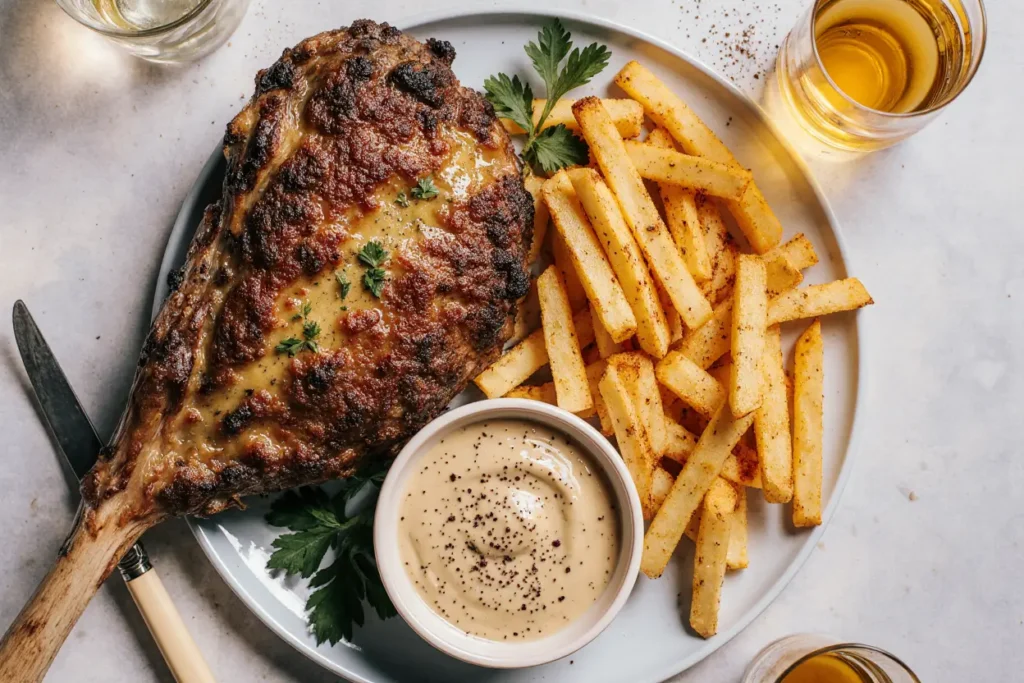
Step-by-Step Instructions: Your Path to Steakhouse Success
Step 1: Prepare and Temper Your Ribeye Steaks
Remove your ribeye steaks from refrigeration 45-60 minutes before cooking. This critical step allows the meat to reach room temperature, ensuring even cooking throughout. Pat the steaks completely dry with paper towels—moisture is the enemy of a good sear. Season generously on all sides with coarse sea salt and freshly cracked black pepper, pressing gently so the seasonings adhere.
Pro Tip: Use approximately ¾ teaspoon of salt per pound of meat. The salt penetrates the surface, enhancing flavor while helping create that coveted caramelized crust.
Step 2: Cut and Soak Your Potatoes
While the steaks temper, scrub your russet potatoes thoroughly but leave the skins on for added texture and nutrition. Cut lengthwise into ½-inch thick planks, then slice into ½-inch sticks, maintaining uniform size for even cooking. Immediately submerge the cut potatoes in a large bowl of cold water for 15-20 minutes. This essential step removes excess starch, resulting in fries that are crispy outside and fluffy inside rather than soggy and limp.
Chef’s Secret: Adding 1 tablespoon of white vinegar to the soaking water helps maintain the potato structure during frying, creating exceptionally crispy results.
Step 3: Execute the First Fry (Blanching)
Drain and thoroughly dry your potato sticks using clean kitchen towels—any remaining water causes dangerous oil splattering. Heat peanut oil in a heavy-bottomed pot or deep fryer to 325°F (163°C), verified with a thermometer. Working in batches to avoid overcrowding, fry the potatoes for 5-6 minutes until they’re cooked through but showing no color. They should be tender when pierced but pale. Remove and drain on paper towels.
Safety Note: Never fill your pot more than halfway with oil, and keep a lid nearby. If oil ignites, smother with the lid—never use water.
Step 4: Craft Your Garlic Butter Sauce
In a small saucepan over medium-low heat, melt the butter until it begins to foam. Add minced garlic and cook for 60-90 seconds, stirring constantly until fragrant but not browned—burned garlic tastes bitter. Remove from heat and stir in fresh parsley, thyme, lemon zest, lemon juice, red pepper flakes, and a pinch of salt. Keep warm on the lowest heat setting, stirring occasionally.
Flavor Enhancement: For deeper complexity, use brown butter by cooking it 2-3 minutes longer until it develops a nutty aroma and amber color before adding garlic.
Step 5: Sear Your Ribeye Steaks to Perfection
Heat a heavy cast-iron skillet or stainless steel pan over high heat until smoking hot—approximately 3-4 minutes. Add your high-smoke-point oil, swirling to coat. Carefully lay the steaks away from you to prevent splatter. Resist the urge to move them. Cook undisturbed for 4-5 minutes until a deep brown crust forms. Flip once and cook another 4-5 minutes for medium-rare (internal temperature of 130-135°F).
During the last 2 minutes, add smashed garlic cloves and rosemary sprigs to the pan. Tilt the pan and use a spoon to baste the steaks repeatedly with the aromatic, herb-infused oil.
Temperature Guide: Use an instant-read thermometer inserted into the thickest part: 120-125°F for rare, 130-135°F for medium-rare, 135-145°F for medium, 145-155°F for medium-well, and 155°F+ for well-done.
Step 6: Rest Your Steaks Properly
Transfer steaks to a cutting board or warm plate and tent loosely with aluminum foil. Rest for 8-10 minutes—this allows the juices to redistribute throughout the meat rather than running out when you cut. During this time, the internal temperature will rise an additional 5°F through carryover cooking.
Why This Matters: Studies show properly rested steaks retain up to 25% more moisture compared to those cut immediately after cooking.
Step 7: Complete the Second Fry for Ultimate Crispiness
While steaks rest, increase your oil temperature to 375°F (190°C). Return the blanched fries to the oil in batches, frying for 2-3 minutes until deep golden brown and audibly crispy. Remove immediately and drain on fresh paper towels. Season generously with sea salt while still hot—the salt adheres better and the flavor penetrates deeper.
Texture Secret: The double-fry method creates a moisture barrier between the exterior and interior, resulting in fries that stay crispy longer.
Step 8: Plate and Serve with Finesse
Arrange fries on warmed plates, creating an attractive base. Slice the rested ribeye against the grain if desired, or present whole. Generously drizzle the warm garlic butter sauce over the steak, allowing it to cascade onto the fries. Garnish with fresh herb sprigs and serve immediately.
Presentation Tip: Reserve some garlic butter sauce in a small pitcher for guests to add more at the table—people love controlling their indulgence level.
Nutritional Information: Understanding Your Steakhouse Meal
Per Serving (based on 2 servings):
- Calories: 1,245 kcal
- Protein: 58g (116% DV)
- Total Fat: 84g (129% DV)
- Saturated Fat: 32g (160% DV)
- Carbohydrates: 62g (21% DV)
- Dietary Fiber: 6g (24% DV)
- Sugars: 2g
- Cholesterol: 215mg (72% DV)
- Sodium: 1,180mg (49% DV)
- Potassium: 1,845mg (53% DV)
- Iron: 6.2mg (34% DV)
- Vitamin B12: 4.8mcg (80% DV)
- Zinc: 12.5mg (83% DV)
Ribeye steak provides exceptional nutritional benefits beyond the macros. It’s one of the richest sources of complete protein, containing all nine essential amino acids your body cannot produce. The high zinc content supports immune function, while B12 is crucial for nervous system health. Ribeye also contains conjugated linoleic acid (CLA), which emerging research suggests may support metabolic health.
The saturated fat content, while substantial, includes stearic acid, which research indicates has a neutral effect on cholesterol levels. Grass-fed beef contains significantly higher levels of omega-3 fatty acids—up to 5 times more than conventional beef—along with elevated vitamin E and beta-carotene.
Healthier Alternatives for the Recipe: Lightening Without Sacrificing Flavor
Leaner Protein Options: Replace ribeye with sirloin or New York strip steaks, reducing fat content by approximately 35% while maintaining excellent flavor. For an even leaner option, filet mignon contains 40% less fat. Alternatively, bison ribeye offers similar marbling with 40% less saturated fat and 35% more protein than beef.
Oven-Baked Fries: Cut oil consumption by 75% by baking fries instead of frying. Toss cut potatoes with just 2 tablespoons of olive oil, spread on a baking sheet, and roast at 450°F for 30-35 minutes, flipping halfway. While texture differs slightly, seasoning with smoked paprika and garlic powder creates compelling flavor.
Air Fryer Method: The ultimate compromise between health and texture—air-fried potatoes use 80% less oil while achieving 90% of the crispiness of deep-fried versions. Cook at 380°F for 20 minutes, shaking basket every 5 minutes.
Garlic Butter Modifications: Create a lighter sauce by using half butter and half extra virgin olive oil, reducing saturated fat by 50%. Alternatively, use ghee (clarified butter), which contains higher amounts of beneficial fatty acids and is lactose-free. For dairy-free diets, high-quality vegan butter with nutritional yeast creates surprising depth.
Sweet Potato Swap: Substitute russet potatoes with sweet potatoes, increasing vitamin A by 400% and fiber by 25%. Sweet potatoes also have a lower glycemic index, causing more gradual blood sugar responses.
Portion Control Strategy: Serve a 6-8 oz steak instead of 12-16 oz, reducing calories by 45% while still providing ample protein. Increase the vegetable component with grilled asparagus or a fresh arugula salad dressed lightly with lemon vinaigrette.
Serving Suggestions: Elevating Your Steakhouse Experience
Classic Steakhouse Presentation: Serve alongside crisp wedge salad with blue cheese dressing, cherry tomatoes, and crispy bacon bits. Add grilled asparagus spears wrapped in prosciutto, lightly charred lemon halves for squeezing, and a small ramekin of horseradish cream for those who enjoy extra kick.
French Bistro Style: Pair with a simple frisée salad dressed with Dijon vinaigrette, cornichons, and grainy mustard on the side. A glass of full-bodied Bordeaux or Cabernet Sauvignon complements the rich flavors beautifully.
Elevated Comfort: Create a steakhouse poutine by topping the fries with beef gravy, cheese curds, and thinly sliced ribeye. Add pickled jalapeños and fresh herbs for a modern twist.
Lighter Balance: Offset the richness with bright, acidic elements: a tomato and burrata salad with basil, grilled broccolini with lemon, or a fennel and orange salad with olive oil.
Wine Pairing Guidance: Bold red wines stand up best to ribeye’s richness. Top choices include Cabernet Sauvignon (dark fruit and tannins cut through fat), Malbec (smooth with peppery notes), or Syrah/Shiraz (bold with black pepper character). For those preferring white wine, an oaked Chardonnay with buttery notes complements the garlic butter sauce beautifully.
Beer Pairing: Rich stouts, porters, or robust amber ales match the intensity of ribeye, while their carbonation helps cleanse the palate between bites.
Common Mistakes to Avoid: Ensuring Success Every Time
Mistake #1: Cooking Cold Steak Data from professional kitchens shows that room-temperature steaks cook 30% more evenly than refrigerator-cold ones. Cold steaks develop overcooked exteriors before the interior reaches proper doneness. Always temper your meat for 45-60 minutes before cooking.
Mistake #2: Overcrowding the Pan Whether searing steak or frying potatoes, overcrowding lowers temperature dramatically, causing steaming instead of searing. This prevents proper browning and flavor development. Always leave space between items—work in batches if necessary.
Mistake #3: Constantly Flipping the Steak Resist the urge to move, flip, or press your steak repeatedly. Each flip delays crust formation. For optimal results, flip only once, allowing 4-5 minutes per side undisturbed for that restaurant-quality crust.
Mistake #4: Cutting Into Steak Immediately Skipping the rest period causes up to 25% of the steak’s juices to run onto the cutting board instead of staying in the meat. Always rest steaks for 8-10 minutes after cooking.
Mistake #5: Using the Wrong Oil Low-smoke-point oils like extra virgin olive oil or butter burn at high temperatures, creating bitter flavors and potentially harmful compounds. Use avocado oil (520°F smoke point), grapeseed oil (420°F), or refined peanut oil (450°F) for high-heat cooking.
Mistake #6: Not Drying Potatoes Thoroughly Even small amounts of water cause violent oil splatter and prevent crispiness. After soaking, dry potatoes meticulously with clean kitchen towels, pressing to absorb all moisture.
Mistake #7: Burning the Garlic Garlic burns quickly, turning bitter within seconds. Cook only until fragrant (60-90 seconds) over medium-low heat, not high. Remove from heat immediately once aromatic.
Mistake #8: Using Dull Knives Attempting to slice steak with dull knives tears the meat fibers, releasing those precious juices you worked hard to retain. Keep knives professionally sharp—a well-maintained blade glides through with minimal pressure.
Mistake #9: Choosing the Wrong Cut Not all ribeyes are equal. Select steaks at least 1.5 inches thick with abundant marbling throughout. Thin steaks overcook quickly, and lean cuts lack the flavor and tenderness ribeye promises.
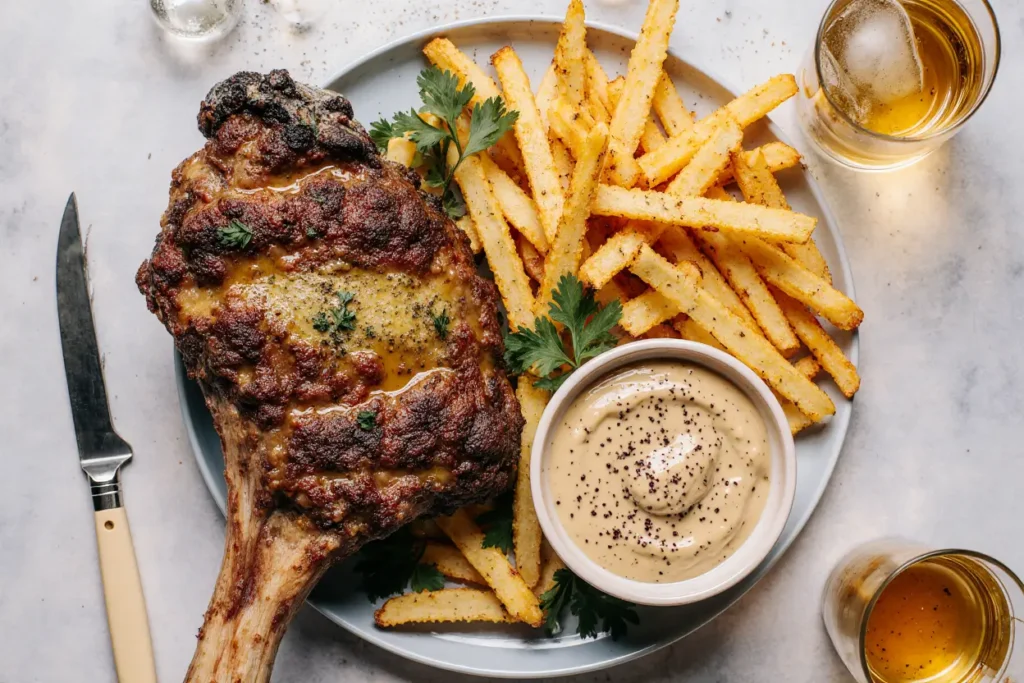
Storing Tips for the Recipe: Maintaining Quality and Safety
Storing Cooked Steak: Allow steaks to cool to room temperature within 2 hours (1 hour if room temperature exceeds 90°F). Wrap tightly in aluminum foil or place in airtight containers. Properly stored cooked ribeye maintains quality for 3-4 days in the refrigerator. For longer storage, freeze for up to 3 months wrapped first in plastic wrap, then aluminum foil, preventing freezer burn.
Reheating Steak Properly: Never microwave ribeye—it turns tough and gray. Instead, bring steak to room temperature (30 minutes), then reheat in a 250°F oven for 15-20 minutes until warmed through. Alternatively, slice thinly and quickly sear in a hot pan for 30-45 seconds per side.
French Fry Storage: Unfortunately, fries don’t store well. Refrigerated fries turn soggy and unappetizing. If you must store them, keep in the refrigerator for 24 hours maximum in an open container (allowing steam to escape). Reheat in a 450°F oven for 5-7 minutes or air fryer at 400°F for 4-5 minutes to restore some crispiness.
Better Fry Strategy: Complete the first fry (blanching stage), drain well, and store blanched fries in the refrigerator for up to 24 hours. Complete the second fry just before serving for optimal freshness and texture.
Garlic Butter Sauce Storage: Store garlic butter sauce in an airtight container in the refrigerator for up to 5 days. The butter will solidify; simply reheat gently over low heat or in the microwave at 50% power, stirring frequently until melted. Alternatively, freeze portions in ice cube trays for up to 3 months—perfect for topping future steaks, pasta, or vegetables.
Raw Steak Storage: Keep raw ribeye in its original packaging in the coldest part of your refrigerator for up to 3-5 days from purchase. For extended storage, freeze immediately in freezer-safe wrapping for up to 6-12 months. Thaw frozen steaks in the refrigerator overnight—never at room temperature, which promotes bacterial growth.
Food Safety Reminder: Always practice proper food safety. Wash hands thoroughly before and after handling raw meat. Use separate cutting boards for meat and vegetables. Cook steaks to safe internal temperatures: 145°F minimum for safe consumption, though medium-rare (130-135°F) is generally safe for whole muscle cuts like ribeye.
Conclusion: Your Steakhouse Journey Begins Now
Mastering ribeye steak with French fries and garlic butter sauce transforms your home kitchen into a destination dining experience. This comprehensive description of techniques, from proper seasoning and tempering to achieving that perfect sear and crafting irresistible garlic butter, empowers you to create restaurant-quality results that impress family and guests alike.
The beauty of this recipe lies in its flexibility—whether you follow it precisely for special occasions or adapt it with healthier alternatives for regular enjoyment, the fundamental techniques remain constant. Each element, from the double-fried potatoes delivering exceptional crunch to the herb-infused butter creating luxurious richness, works in harmony to create a meal that satisfies on every level.
Remember that cooking excellence develops through practice. Your first attempt might not achieve steakhouse perfection, but each experience builds your skills and confidence. Pay attention to temperatures, timing, and the sensory cues—the sizzle of a proper sear, the golden color of perfectly fried potatoes, the fragrant aroma of garlic butter.
Now it’s your turn to bring this steakhouse experience to life. Gather your ingredients, heat your pans, and prepare to enjoy one of the most satisfying meals you’ll create at home. Don’t forget to share your results—post photos of your beautiful ribeye creations, tag fellow food enthusiasts, and inspire others to elevate their home cooking. Your perfect steakhouse dinner awaits, and it’s closer than you think—just inside your own kitchen.
FAQs: Your Questions Answered
Q: What’s the best way to know when my steak is done without cutting into it?
A: Use an instant-read meat thermometer inserted into the thickest part of the steak, avoiding bone and fat. For medium-rare, remove the steak from heat at 130-135°F. Alternatively, use the touch test: press the steak’s center with your finger—it should feel like the fleshy part of your palm when you touch your thumb to your middle finger (medium-rare). With practice, this method becomes reliable, though beginners should trust the thermometer.
Q: Can I make this recipe if I don’t have a deep fryer?
A: Absolutely. Use a heavy-bottomed pot filled no more than halfway with oil, maintaining temperature with a thermometer. Alternatively, oven-bake or air-fry the potatoes as detailed in the healthier alternatives section. While texture differs slightly from traditional deep-frying, both methods produce delicious results with significantly less oil.
Q: My steak always seems tough. What am I doing wrong?
A: Three common causes: choosing a lean cut instead of well-marbled ribeye, overcooking past medium (145°F+), or cutting with the grain instead of against it. Always select ribeye with visible white marbling, cook to no more than 145°F internal temperature, and slice perpendicular to the muscle fibers. Also ensure you’re resting the steak properly—this makes a 20-25% difference in tenderness.
Q: How do I prevent my garlic from burning in the butter sauce?
A: Use medium-low heat and add garlic to already-melted butter rather than cold butter. Cook for only 60-90 seconds until fragrant, stirring constantly. The moment it becomes aromatic, remove from heat immediately—garlic continues cooking in the hot butter even off the flame. If concerned, remove the pan from heat, wait 30 seconds for it to cool slightly, then add garlic for even gentler cooking.
Q: Can I prepare any components ahead of time for easier entertaining?
A: Yes! Complete the first fry of potatoes up to 24 hours ahead and refrigerate. Prepare the garlic butter sauce up to 5 days in advance and store refrigerated. Season steaks up to 2 hours before cooking and refrigerate uncovered (this actually helps dry the surface for better searing). Bring everything to appropriate temperatures 45-60 minutes before cooking, then execute the final steps while guests enjoy appetizers.
Q: What if I prefer my steak well-done but want it to stay juicy?
A: Well-done steaks (155°F+) naturally lose more moisture, but you can minimize this. Use a reverse-sear method: cook the steak in a 275°F oven until it reaches 145°F internally (about 20 minutes), then sear quickly in a screaming-hot pan for 60-90 seconds per side. This gentle cooking followed by quick searing provides more even doneness with better moisture retention. Alternatively, choose a thicker cut (2+ inches) which tolerates longer cooking better.
Q: Are the fries really worth the double-fry effort?
A: Absolutely, especially for special occasions. The double-fry method creates fries that are 60-70% crispier and maintain that crispiness 3 times longer than single-fried versions. The first fry cooks the interior, while the second creates an ultra-crispy exterior shell that’s noticeably superior. If time is limited, the air fryer method provides a reasonable compromise at 85% of the quality with 60% less effort.

